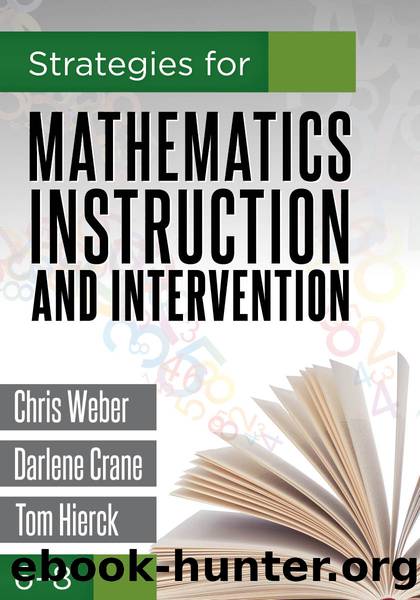Strategies for Mathematics Instruction and Intervention, 6-8 by Weber Chris;Crane Darlene; & Darlene Crane & Tom Hierck

Author:Weber, Chris;Crane, Darlene; & Darlene Crane & Tom Hierck
Language: eng
Format: epub
Publisher: Solution Tree
Published: 2015-08-15T00:00:00+00:00
Figure 3.9: Sample student journalâmetacognition for mathematical learning.
While metacognition has traditionally been linked with learn to learn and thinking about thinking practices, like the use of concept maps, mnemonics, and study strategies, we propose that metacognition is much broader in its application to mathematical learning and should be modeled and explicitly connected to all elements of learning. The Singapore syllabus for mathematics defines metacognition within a mathematics context as (Yoong, 2002):
⢠Consistent and intentional monitoring of thinking while carrying out a task
⢠Seeking alternate strategies or approaches
⢠Monitoring the reasonableness of an answer
We believe this summary of metacognition encapsulates the intent of all mathematical practices and should be explicitly integrated into mathematics education from the earliest of ages. The modeling and practicing of these metacognitive processes would help create a classroom culture that accepts that mathematics can be messy and that multiple solutions and strategies are acceptable and valuable. In middle school classrooms, metacognitive practices can be modeled through teacher think-alouds and student think-alongs (whole-class or small-group think-alouds followed by sharing strategies, approaches, and ideas) (Yoong, 2002). Rather than begin instruction with a preplanned, presolved problem to model a solution step by step, instruction with mathematics concepts can begin with explorations of new concepts with connections to previous ideas. This should include the modeling and practice of the metacognitive skills that demonstrate that first approaches do not always work.
Researcher and author Alan Schoenfeld (1987) suggests that students can be taught a set of favorite questions to integrate into problem-solving activities to promote the enduring use of metacognitive mathematics practices. Questions include: What are you doing? Why are you doing it this way? and How does this help you? While teachers can adapt these questions, they should be introduced within the context of authentic problem-solving experiences (figure 3.10). We suggest teachers model these questions first within the context of a think-aloud and then within group-shared think-alongs. Students should then be guided to use these same or alternate favorite questions with each other and to use these questions to monitor their own and each otherâs thinking.
Our school is purchasing new sporting equipment for the soccer teams. We have $3,875 to spend. We have quotes from two different companies and have to decide which company is offering us the best value.
World of Soccer has offered the school a 15 percent discount on the total $3,875 order and free shipping.
Soccer Warehouse has offered the school a 15 percent discount on the first $2,000 spent and a 20 percent discount on everything over $2,000. Soccer Warehouse will charge a 3 percent shipping fee.
Download
This site does not store any files on its server. We only index and link to content provided by other sites. Please contact the content providers to delete copyright contents if any and email us, we'll remove relevant links or contents immediately.
| Applied | Geometry & Topology |
| History | Infinity |
| Mathematical Analysis | Matrices |
| Number Systems | Popular & Elementary |
| Pure Mathematics | Reference |
| Research | Study & Teaching |
| Transformations | Trigonometry |
Modelling of Convective Heat and Mass Transfer in Rotating Flows by Igor V. Shevchuk(6245)
Weapons of Math Destruction by Cathy O'Neil(5876)
Factfulness: Ten Reasons We're Wrong About the World – and Why Things Are Better Than You Think by Hans Rosling(4510)
Descartes' Error by Antonio Damasio(3175)
A Mind For Numbers: How to Excel at Math and Science (Even If You Flunked Algebra) by Barbara Oakley(3117)
Factfulness_Ten Reasons We're Wrong About the World_and Why Things Are Better Than You Think by Hans Rosling(3061)
TCP IP by Todd Lammle(3025)
Applied Predictive Modeling by Max Kuhn & Kjell Johnson(2921)
Fooled by Randomness: The Hidden Role of Chance in Life and in the Markets by Nassim Nicholas Taleb(2886)
The Tyranny of Metrics by Jerry Z. Muller(2870)
The Book of Numbers by Peter Bentley(2797)
The Great Unknown by Marcus du Sautoy(2552)
Once Upon an Algorithm by Martin Erwig(2486)
Easy Algebra Step-by-Step by Sandra Luna McCune(2480)
Lady Luck by Kristen Ashley(2427)
Practical Guide To Principal Component Methods in R (Multivariate Analysis Book 2) by Alboukadel Kassambara(2395)
Police Exams Prep 2018-2019 by Kaplan Test Prep(2372)
All Things Reconsidered by Bill Thompson III(2273)
Linear Time-Invariant Systems, Behaviors and Modules by Ulrich Oberst & Martin Scheicher & Ingrid Scheicher(2249)
